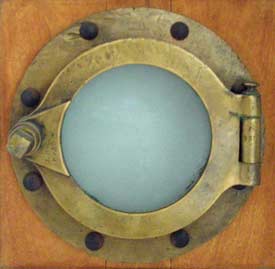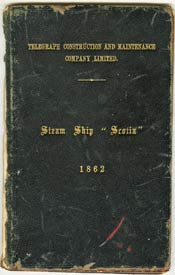|
CS SCOTIA
Built in 1861 by R. Napier & Co,. Glasgow
Length 379.0 ft Breadth 47.8 ft Depth 20.0 ft Gross tonnage 3871
Built originally for Samuel Cunard in 1862 for the Atlantic service; the largest ship afloat at the time with the exception of Great Eastern. Held the Blue Riband eastbound for five years and westbound for four years. Laid up in Liverpool from 1875 until purchased in 1879 by the Telegraph Construction and Maintenance Company. Converted for cable laying and fitted with new engines by Laird Brothers.

Scotia recovered porthole
Image courtesy of and copyright © 2015 Paul Edwards |
Three tanks were installed, No 1, 36 ft dia by 26 ft deep; No 2, 40 ft dia by 23 ft deep; No 3, 37 ft dia by 15 ft deep, giving a total capacity of 69441 cu ft. Two paying out-picking up machines were situated on the main deck and a single paying out machine was placed aft. Twin bow and one stern sheaves were fitted.
Sold in 1903 to the Commercial Pacific Cable Co. Broke her back on a reef at Catalan Island, Guam in 1904.
In the mid-1970s Paul Edwards, a diver and former resident of Guam, recovered a porthole from the wreck of Scotia. Paul notes that at the time, the ship’s “boilers, double bottom, and engine crankshaft were still readily apparent.”
Scientific American 28 June 1879
The Steamship Scotia
Many of our people, from having frequently crossed the Atlantic in the steamship Scotia, the last side-wheel steamer built for the Cunard Company, will be glad to know what has become of their favorite vessel. A foreign contemporary gives the following account of her:
Few would recognize in the large twin screw steamer which left the Mersey lately, the once famous Cunard liner Scotia, the last of the great paddle steamers built for the Atlantic trade, and which, under the command of the late Captain Judkins, was for years looked upon as the fastest and favorite vessel on the line between Liverpool and New York. The Scotia was built in 1862, when, with the exception of the Great Eastern, she was probably the largest mail steamer afloat, being about 400 feet long over all, 47 feet 8 inches beam, and 4,050 tons builder’s measurement, and fitted with a pair of side lever engines of 1,000 horse power.

Book of specifications for Steam Ship "Scotia" published by Telcon after their acquisition of the ship.
9.5" x 6", 16 pages
|
|
The introduction of screw steamers fitted with compound engines for the Atlantic and other ocean voyages has, of late years, entirely superseded the paddle steamers, and a few years back the Scotia was withdrawn from the Cunard Company’s sailing list, and was subsequently purchased by the Telegraph Construction and Maintenance Company to be employed in their cable-laying operations.
Extensive alterations were made by Messrs. Laird Brothers, at Birkenhead Ironworks. The Scotia has been stripped of her masts, funnels, machinery, paddle wheels and paddle boxes, deckhouses, etc.; she has also been raised by the addition of a spar deck, and altered about the after end to prepare her for twin screws, and has been fitted with new compound engines, and also provided with three immense cylindrical tanks in which to stow the electric cable, as well as with most elaborate and approved steam machinery for paying out and hauling in, also steam capstan, steam steering gear, winches, etc.
The new engines are two distinct sets, on the compound system, with inverted cylinders, 38 inches, and 66 inches diameter, and 3 feet 9 inches stroke, supplied with steam at 75 lb. pressure from three double-ended cylindrical boilers, and are calculated to drive the vessel at a speed of about 11½ knots an hour.
CABLE WORK
| Captain W.R. Cato: |
| 1879 |
Penang - Malacca - Singapore - Banjoewangie, DEI |
| 1880 |
Aden - Zanzibar |
| 1880 |
Renewed major part of 1866 Trans Atlantic cable |
| 1882 |
Greetsiel - Borkum, Germany - Valentia, Ireland |
| 1883 |
Vladivostock, Russia - Nagasaki, Japan - Shanghai, China |
| 1883 |
Hong Kong - Foochow - Shanghai, China |
| 1884 |
The Lizard, England - Bilbao, Spain |
| 1884 |
Madeira - St Vincent, Cape Verde Islands |
| 1884 |
St Vincent, Cape Verde Islands - Pernambuco, Brazil |
| 1885 |
Bathurst, Gambia - Freetown, Sierra Leone - Accra, Gold Coast - Lagos - Brass - Bonny, Nigeria |
| 1887 |
Porthcurno - Carcavelos - Gibraltar - Malta - Zante |
| 1889 |
Cape Town - Mossamedes |
| 1890 |
Sydney - Wellington |
| 1890 |
Aden - Suez, Egypt |
| 1891 |
Fano - Oye, Denmark |
| 1893 |
Zanzibar - Seychelles - Mauritius |
| 1894 |
Valentia Island, Ireland - Hearts Content, Newfoundland |
| 1894 |
Singapore - Labuan |
| 1894 |
Labuan - Menumbok, Sabah |
| 1894 |
Labuan - Hong Kong |
| 1896 |
Greetsiel - Borkum, Germany - Vigo, Spain |
| 1898 |
Jamaica - Turks Island - Bermuda |
| 1898 |
Porthcurno, England - Gibraltar |
| |
|
| Captain H. Woodcock: |
| 1900 |
Rio de Janeiro - Pernambuco - Para, Brazil |
| 1900 |
Montevideo - Maldonado - Rio de Janeiro |
| 1901 |
Cocos (Keeling) Islands - Cottesloe, Perth, W. Australia - Glenelg, Adelaide, S. Australia |
| 1901 |
North Sydney, Nova Scotia - St Pierre et Miquelon - Bay Roberts, USA |
| 19021 |
Cottesloe, Perth, W. Australia - Adelaide, S. Australia |
CABLE REPAIRS
Capt W.R. Cato: |
1880 |
1866 and 1873 Atlantic |
1881 |
1869 Brest, France - St. Pierre |
1882 |
Valentia - Greetsiel |
1882 |
Brest St. Pierre cable, 3 faults |
1883 |
St. Vincent - Pernambuco |
1884 |
St. Vincent - Pernambuco near St. Vincent |
1884 |
Madeira - St Vincent, CVI 2 repairs, near St. Vincent, near Ferro |
1888 |
Ballinskelligs - Halifax 2 faults |
1890 |
Cook Straits, New Zealand |
1891 |
Carcavelos - Madeira 1873 cable |
1892 |
Maldonado - Chuy at Maldonado |
1892 |
Pernambuco - Bahia, 2 repairs |
|
|
Capt. H. Woodcock: |
1900 |
St. Vincent - Pernambuco 1884 cable |
CS Scotia stamps from Bill Glover’s collection:
|

